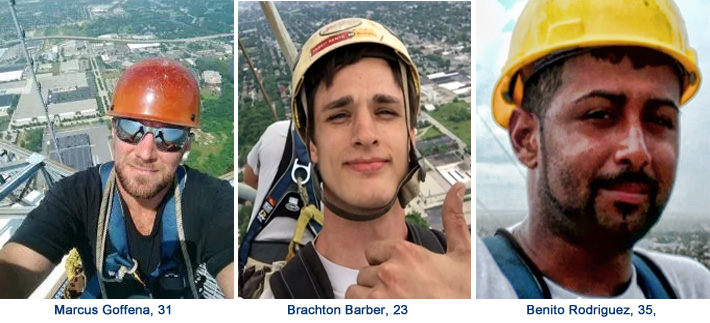
Three tall tower technicians died last September after the faulty rigging plan they were following caused their gin pole attachments to fail.
Calculation errors in an engineer’s rigging plan is being cited as the reason a gin pole broke loose from the 1,000-foot Miami, Fla. tower it was attached to, causing the death last September of three tall tower technicians employed by Tower King II, Inc. of Cedar Hill, Tex.
The disclosure came to light this afternoon from Tower King II’s attorney, Tod T. Morrow, who provided a response to an OSHA Serious citation issued against his client yesterday in connection with the Sept. 27, 2017 fatal equipment collapse.
He believes the maximum $12,934 fine is completely unjustified and he has taken steps to appeal it.
Morrow is convinced that OSHA could not find any violations of specific safety regulations, so it resorted to the use of a catch-all clause in the OSHA Act, Section 5(a)(1) that requires companies to generally furnish a safe place of employment.
“Tower King II has demonstrated a strong commitment to worker safety,” said Morrow. “The company consulted several experts in the tower safety industry and asked them to perform a thorough accident investigation. Both the company and its experts have concluded that the accident was caused by the failure of a third-party engineering firm to properly calculate the stress factors on the rigging used to secure the equipment to the TV tower,” Morrow stated.
“It is our belief that a mistake in the engineering plan caused an overloading of the rigging components, ultimately causing them to fail.”
“Essentially, OSHA concluded that Tower King II, should have hired another engineer to review the work of the first firm and supervise the rigging process. The law, however, contains no such requirement, and that is entirely inconsistent with industry practice.” Morrow said. “Tower King II was completely justified in relying upon the engineered rigging plan.”
In a March 27 press release, Condell Eastmond, Fort Lauderdale OSHA Office Director said, ‘This tragedy underscores the importance of having a qualified individual conduct an analysis before performing construction work on communication towers.”
The statement also said that” investigators determined that the employer failed to ensure the capacity of the rigging attachments were adequate to support the forces imposed from hoisting loads.”
“The OSHA press release was inaccurate and misleading,” Morrow said. “OSHA implied that the company never secured a rigging plan from a qualified engineer. That is not true. The problem was that the workers, who were qualified and experienced riggers, followed the recommendations of a faulty plan.”
It is noteworthy, Morrow said, that following the accident, Tower King II completed the job without incident by utilizing a rigging plan with the correct calculations.
“This was an unfortunate accident that took the lives of three experienced and valued employees, one of whom was the step-son of the company owner,” Morrow said.
The OSHA citation identifies an abatement method that could be used by following and implementing ANSI/ASSE A10.48-2016, stating: “Section 4.8: Ensuring a complete rigging plan is developed and implemented. Ensuring a qualified engineer performs analysis of Class IV construction work to be performed on the communication tower, including, but not limited to the means and methods of the rigging attachments of the gin pole to the tower.”
However, Section 4.8 does not provide that information and it appears to be an interpretation of Eastmond of what could be done rather what is written in the ANSI standard.
Prior to issuing the citation, Eastmond was aware that the technicians had followed the rigging plan and the attachments failed since the loads were incorrectly specified by the unnamed engineer, according to individuals knowledgeable of OSHA’s investigation.
An OSHA administrator informed Wireless Estimator that they would clarify whether this was correct, but provided no further response.
Morrow informed Wireless Estimator that Tower King II has already filed a Notice of Contest with the Occupational Safety & Health Review Commission in Washington, D.C. Morrow states that he is optimistic that the company will prevail on its appeal.













